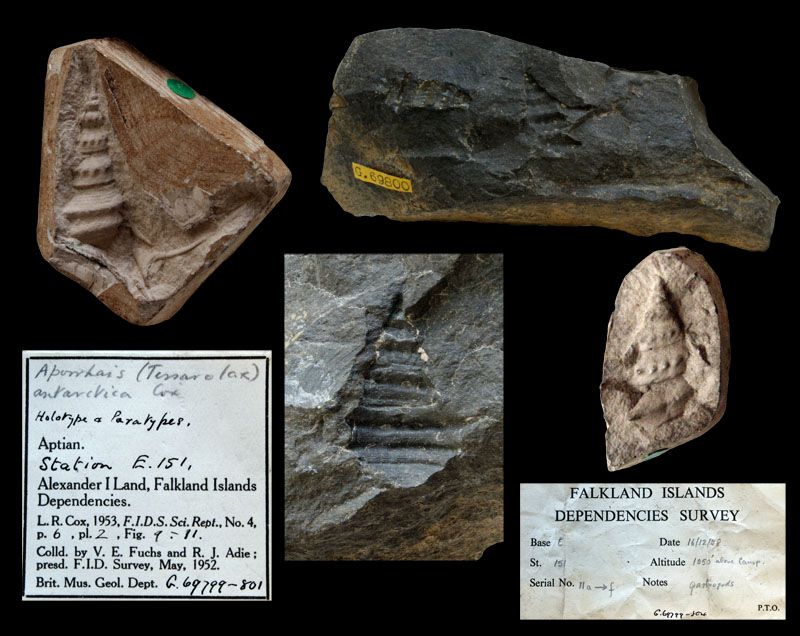|
edit SideBar
|
Species / Tessarolax Antarctica
Stromboidea
Original description of Aporrhais (Tessarolax) antarctica by Cox, 1953:
- "Shell of medium size (height about 45 mm.) and stoutness, with a moderately long, narrow, straight anterior rostrum. Earlier whorls obtusely angular in the middle, the angle bearing small tubercles. Penultimate whorl with a prominent rounded keel, without tubercles, continuing this angle, and with a second rounded keel just visible above the lower suture. Last whorl with two conspicuous, rounded keels which continue those of the penultimate whorl and are separated by a strongly concave band; a third keel, less prominent, lies below them. Faint spiral threads are present on the whole surface of the shell, including the base. Outer lip with two long and very narrow digitations continuing the main keels, the upper one curving upwards to a slight extent. The upper edge of the last whorl stands out as a thin ridge bordering the suture and bends upwards at the termination of the whorl, suggesting that there was a digitation adhering to the spire. The external mould in which this feature is observable is, however, broken away so that the impression of the digitation itself is mi,ssing."
Locus typicus: Fossil Bluff (lat. 71°10'S., long. 68°19'W.), Alexander Island, west of Palmer Land, Antarctic Peninsula, Antarctica
Stratum typicum: Aptian, lower Cretaceous
Aporrhais (Tessarolax) antarctica (Cox, 1953); Aptian, lower Cretaceous; Fossil Bluff, Alexander Island, west of Palmer Land, Antarctic Peninsula, Antarctica; Coll. BM(NH) nos. G.69799 to G.69801; Copyright BM(NH)
Comment Han Stoutjesdijk:
- This species is no Tessarolax. It might be genus between Dicroloma and Struthiochenopus
History and Synonymy
2014
Cataldo 2014, p. 1228:
- "Amongst the three aporrhaid species reported from the Lower Cretaceous of Alexander I Island, Antarctica, Anchura? antarctica (Cox, 1953, p. 6, pl. 2, figs. 9–11; Thomson, 1971, p. 52, fig. 3a–3d) bears some resemblance to P. neuquensis due to its bicarinate spire whorls, tricarinate last whorl and outer lip. The labrum expands in a very short wing that rapidly extends into two diverging lateral labral processes, although not as long, thin, and delicate as in the Argentinean species. The posterior lateral labral process in A.? antarctica is bent adapically and the anterior one is shorter and bent abapically. The rostrum is also similar to that of P. neuquensis, although shorter and bent to the right. The main difference between these species remains in the nodose sculpture of A.? antarctica and the high turriculate spire with a lower mean spire angle."
2015
Saul & Squires, 2015, p. 44:
- "Aporrhais (Tessarolax) antarctica Cox (1953:6, pl. 2, figs. 9–11) from Aptian deposits on Alexander I Island, Falkland Islands Dependencies, is based on six molds, all more or less incomplete. All spires are very tall for Tessarolax, the posterior carina has stronger nodes than have been otherwise seen on Tessarolax, and the outer anterior lip digitation is wider than that of Tessarolax. These features suggest that Cox’s species is a Pietteia Cossmann, 1904. Cox’s species (1953:pl. 2, fig. 10) might have a small fictavarix-like structure on the left side of its last whorl. Genus Pietteia can have a fictavarix, as shown by the Early Cretaceous species Pietteia cretacea Kase in Kase and Maseda (1980:311–313, pl. 36, figs. 4–10, text-fig. 9), which has a small but distinct, spine-like fictavarix on its last whorl."
References:
|

